by Dave Weber images by Doug Breithaupt |
Back when I was a child, these cars were popular automobiles. For about the first 10 years of my life, my father owned a 1941 Studebaker Champion 4 door model. My uncle also owned a similar sedan and two of my parents closest friends were the local Studebaker dealer and his wife. Later, our next door neighbor owned a 1953 Starlight Loewy designed sports coupe which was a design forerunner to the famed Hawk series. The Studebaker family name as a manufacturing firm goes back to 1852. The Studebaker Brothers of South Bend, IN began producing horse-drawn wagons. This enabled families and produce to travel into new areas of development. With the inventions of the combustion engine and electric power, there was less demand for horse-drawn vehicles. The Studebaker Wagon Co began producing automobiles in 1902. Various makes and models were offered by the parent company. Names such as E-M-F, Flanders 20, Studebaker- Garford and Studebaker Electric were introduced at the beginning of the 20th Century. But the only make to remain into the 1920's carried the parent company name. Additional makes, Erskine (1927-1930) and Rockne (1932-1933) appeared during the Depression Era . These cars were introduced as less expensive companions to the Studebaker . Also, from 1929-1933 the Pierce- Arrow cars were part of this corporation. Prior to WWW, the Studebaker car was not very stylish. I question why consumers chose this car over the more modern versions of other more prominent manufacturers of the time. But after the War, the Studebaker became one of the most radically styled cars of that time period. This styling concept became even more radical when Designer Raymond Loewy introduced the 'bullet nose' models of 1950-1951. This idea may have been taken from the already defunct Tucker concept of 1948 with the center headlight characteristic. In fact, a modified Studebaker was used in the Tucker movie about 10 years ago to portray a test crash scene . Loewy's low and sleek designs; especially in the 2 door Starlight and Speedster models lead to the introduction of the renowned Hawk series in 1956. This series continued in production until near the demise of this company in 1966. In 1956 the merger of Studebaker with the elite Packard Motor Car Company occurred . Management hoped the combination would breathe new life into both former companies .However, the decision to put a Packard name on a less expensive Studebaker styled body in 1957 resulted in the end of the Packard marque in 1958. A new smaller compact Studebaker was introduced in 1959 and was called the Lark. it became the companion to the larger Hawk series. In 1963 the Avanti fiberglass bodied sports car was introduced which also was very radical in style for its time. Although the parent corporation became defunct in 1966, the Avanti ll continued independently in limited production until recently. Various model and toy companies have produced replicas of some of these cars; especially in larger scales than 1/64. However, there are a few models that have been made available over the years in this scale, but not nearly as many as I would like to see produced in this favored size. |
 '50 Studebaker Wagon hot rod - Hot Wheels 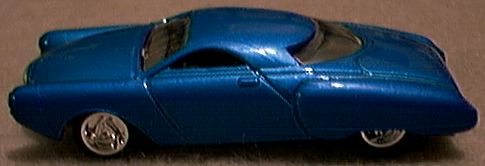 Frankenstude (1951) - Johnny Lightning 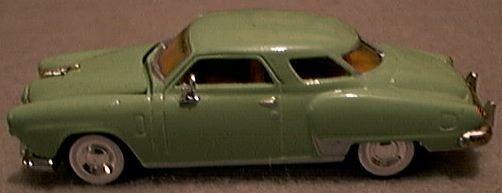 1951 Studebaker Champion - Racing Champions 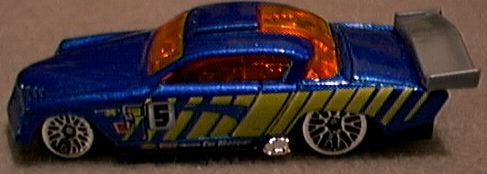 1953 Studebaker Starliner Coupe 'At-A-Tude' drag racer - Hot Wheels 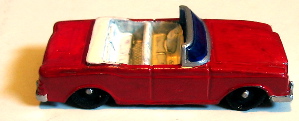 1960 Studebaker Lark Convertible - Tootsietoy (re-painted) 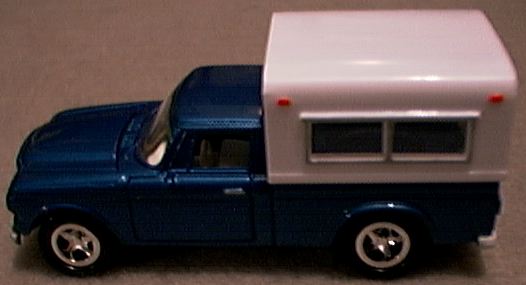 1964 Studebaker Champ Pick-up - Johnny Lightning  1964 Studebaker Lark Wagonaire - Matchbox 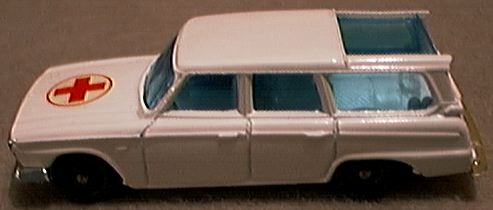 1964 Studebaker Lark Wagonaire Ambulance - Husky (Corgi) Packard 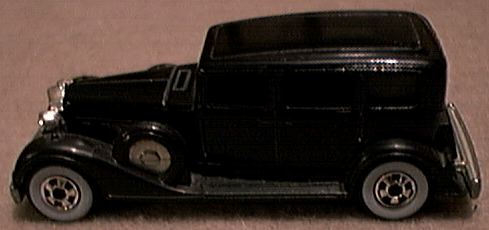 1934 Packard Sedan - Hot Wheels 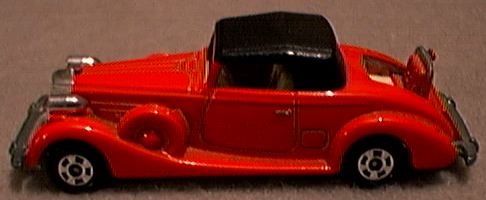 1937 Packard Convertible - Tomica 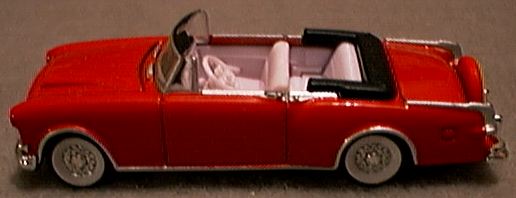 1953 Packard Caribbean Convertible - Racing Champions |
Studebaker in 1/64 scale Unfortunately I cannot claim to have all of the following models. This list is an attempt to provide a composite rundown of all known models in this scale of both past and present availability. A very informative and authoritative source for early and no longer available models is 'Detroit In Minature' by Wieland and Force published in 1983. The following is a chronological listing of known models. A 1940 4 door sedan taxi was produced by Barclay under model #318. This firm was mainly known for their slush mold models, but Wieland and Force list both a diecast and slush model of this car. Barclay has been out of business since 1971 and was located in the North Jersey area when in operation. A 1947 Champion sedan was produced by Allied, an early post war producer of plastic toys. Tootsietoy issued a 1947 Champion 5 window coupe. It did not have a base plate and the axles were attached to 4 posts extending from the underside of the one piece body . This model is reported to be very rare and has a high sale price when it can be found. Last year McDonalds provided a 1950 customized version of a Studebaker in station wagon form.It was identified as a Hot Wheels licensed product and has McDonalds logos on it. The designer took great liberties to modify this model from that of the full size vehicle. Plus , it appears that no station wagons were produced in 1950! The 1951 custom Frankenstude by Johnny Lightning represents a another attempt to radically alter the original coupe . This model represents a car that underwent a major roof / cabin area chop. It is black in color and was first issued in the JL Hot Rods set in 1998. Racing Champions produced a 1951 Mint Edition version # 150 during 1998. This casting was also used in the subsequent Police series . A 1953 Champion model by Goodee , a now defunct company from NJ , was issued in a stylized approach similar to the Tootsietoy designs. The Hot Wheels 1953 At-A-Tude was issued as a First Edition in 1998. The body design has been modified to portray this vehicle as a dragster. A 1958 Hawk was issued by Hubley Toy Company of Lancaster PA in the late 50's and early 60's in the Real Toy series as # 442. Companion models were also produced in Canada in the Real Type series as # RT 50.These models are excellent representations of the full size car. Availability is scarce. Tootsietoy also produced a second Studebaker in their characteristic one piece body style as a 1960 Lark Convertible A very nice representation of a 60's Champ pickup truck was first produced in 1998 by JL and was part of their Truckin America set. The engine hood opens to reveal the shape of the engine inside the compartment. The body came in several colors. Galoob produced a 1963 Avanti in their Macro series. The casting is distorted in that the body width is out of proportion to the length. The base is copyrighted in 1991. Galoob, known at present for their microcar models produced this model with blanked out windows. Some of these models were provided with a front spring action bumper. When pushed inward, crash sounds can be heard from inside the casting. The 1964-65 Lark Wagonaire was first made by Husky, the predecessor to Corgi Jr. This model carried #15 from 1967-1970. It was available in yellow, blue, turquoise and lime. It was originally issued as a TV camera vehicle but later became available as a regular wagon in the Corgi Jr / Whizwheels line which lasted into 1971. From 1971 to approximately 1973 this casting was modified to represent an ambulance equipped with sirens in white under # 30. Matchbox/ Lesney also issued a 1964-65 Lark Wagonaire under model # 42-B in 1965 in various shades of blue. It remained in production until 1969. The main feature was a sliding rear plastic roof section. When issued, it was accompanied by a plastic model hunter and two dogs in white. Packards in 1/64 scale The Packard Motor Car Company began their manufacturing operation in 1899 and continued until 1958. Although there are representative models of vintage cars in larger scales, none are available in 1/64. The earliest models in this scale represent the 1930 model in its prime as a 'classic' automobile. I have 5 different models identified by their respective manufacturers that are identified as 1930. Each is listed in alphabetical order . CLE of France produced a black and white plastic kit model of the roadster . This kit was provided as a promotional by the Cities Service/ Citgo fuel stations in 1969. The detailing is excellent. Even small mirrors were provided to be placed on the front fender mounted spare tires. Guisval of Spain produced a very accurate diecast model of a boat tail roadster in red and black during the early 90's. Unfortunately, I doubt that these models are still available. I also have a blue roadster which was made in China . The body is slightly stylized . No other info is available on this diecast model . Lindberg , a plastic model company issued a dual cowl phaeton model in kit form over 25 years ago . It was part of the Mini-Lindy series and carried # 21. Although a second set of Mini- Lindys was reissued in 1990, this model was not included. Summer, a toy company in the Orient, known for their less refined products, produced model # S 8306 in their Classic Car series almost 10 years ago. As usual, this is more of a toy than an accurate model. It is a boat tail roadster with a red body , dark blue fenders and a light blue canvas roof in the lowered position. Hot Wheels issued a very realistic 1934 'Classic Packard' 4 door sedan in black for the first time in 1983 under model # 3920. There are spare tires mounted in both front fenders. This model occasionally reappears and is available from some dealers at present. With a slanted radiator and more stylish body, a few toy makers chose to produce the 1937 car. The first model is a roadster made in China. There is no identification except for the model # 6011 and the indication it is a pull back motorized model. Details are stylized in the Summer tradition. Laramie Toy Company still located in the Phila/ S. Jersey area produced a yellow roadster in their short lived Richie Rich Old Timers set over 10 years ago. The base identifies this model as a 1/72 Packard Coupe Roadster made in Hong Kong. It has a yellow body with black fenders and has a very strong resemblance to the more detailed model produced by Tomy/ Tomica of Japan. Tomica produced the roadster with a copyright date of 1978 . It also is identified as 1/72 and carries model # F-52 . Both the Tomica and Laramie models are larger than 1/72 scale and compare in size fairly closely to other models in 1/64 scale. The Tomica model is painted red with a black top and is equipped with a rumble seat that opens and closes. Detailing is excellent and Tomy has even depicted a door behind the driver door for golf bag storage as in the full size car. Such details as this and others are omitted from the Laramie version . But the basic castings are from the same design. Budgie/ Morestone of England produced a 1952 Mayfair convertible as model # 14 in 1957. It is cream colored with the top in the stowed position. It was available until 1970. Finally Racing Champions issued a 1953 Caribbean convertible in 2000 as model # 25 in their short lived Classified Classics series. The body is red with a white interior and a black top in the lowered position and is an excellent representation of the real car. This completes my review of the models in 1/64 scale that I know about. Any additions and corrections are always welcome. Hopefully the present toy manufacturers will soon recognize the need for more Hawks, Caribbeans, Larks and Avantis etc, instead of producing repetitive castings of some other makes that are now quite plentiful. |